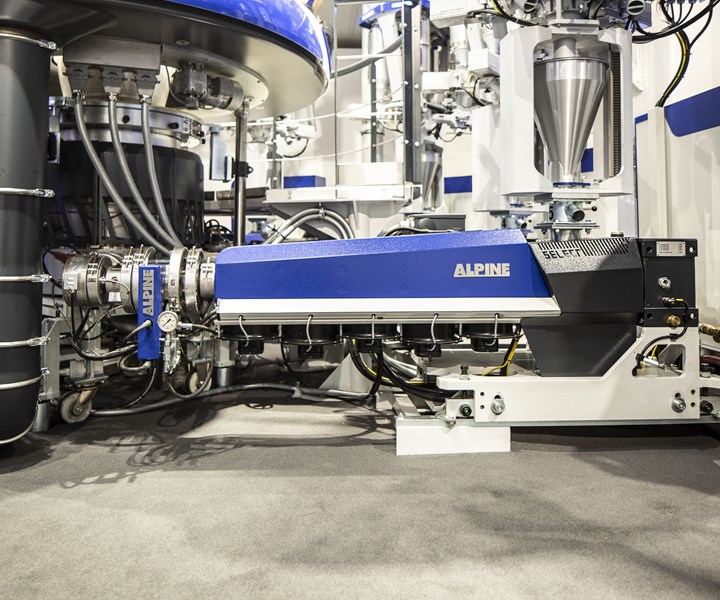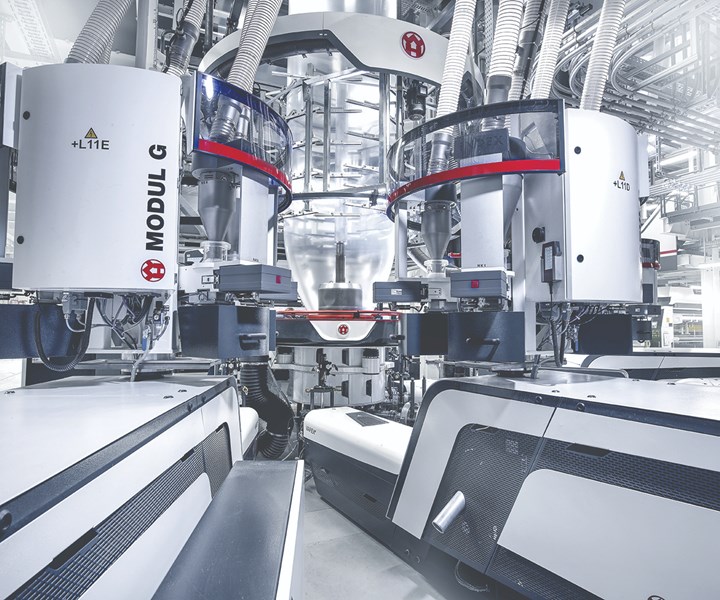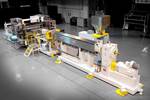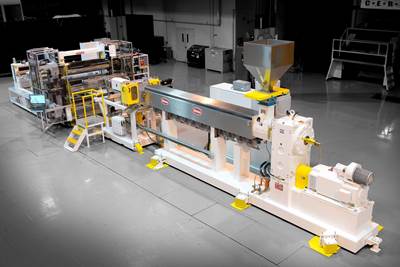More than a dozen blown film lines were humming each day during October’s K 2019 show in Düsseldorf. Responding to demand from consumers and brand owners, more than half of these machine builders debuted all-polyolefin multi-layer extrusion technology to facilitate recycling. All-polyolefin coextrusions for applications such as standup pouches abounded, included in show floor displays or at open houses that ran concurrent with the show from machine builders such as Bandera, Hosokawa Alpine, Kuhne, Macchi, Reifenhauser, and Windmoeller & Hoelscher, among others.
What follows in this article is new technology not previously covered in Plastics Technology’s September 2019 K Show Preview, as well as product launches that were featured in our Keeping Up with Technology section in the September, October, November, and December issues.
In addition to using recyclable materials in support of sustainability efforts, machine builders also debuted technology aimed at boosting efficiency of film processing. Hosokawa Alpine took the wraps off its newly developed HX Select series extruders that is said to be flexible enough to run LLDPE, mLLDPE, PCR (post-customer recycle) and bioplastics. A new screw and barrel design is said to permit energy savings up to 20% along with significantly lower melt temperatures and much higher throughput. This, in turn, results in increased bubble stability at lower cooling requirements. The series is available with screw diameters from 50 to and 120 mm.
 Hosokawa Alpine’s HX Select series extruders feature a new screw and barrel design that is said to permit energy savings up to 20% along with lower melt temperatures and higher throughput. The series is available with screw diameters from 50 to and 120 mm.
Hosokawa Alpine’s HX Select series extruders feature a new screw and barrel design that is said to permit energy savings up to 20% along with lower melt temperatures and higher throughput. The series is available with screw diameters from 50 to and 120 mm.Hosokawa Alpine also showcased a high-efficiency cooling package for blown film consisting of the Alpine CRX cooling ring for outer cooling and the Alpine HT cooling tower for inner bubble cooling. The CRX series is described as a low-counterpressure system that reportedly makes more efficient use of the available cooling capacity and increases throughputs. The base body is thermally insulated and also contributes to increased energy efficiency. The high-performance cooling ring is also characterized by optimized air distribution, resulting in improved film tolerance. Since the Alpine CRX has only a single cooling-air supply line, it more user friendly for operators and maintenance personnel.
The HT cooling tower, meantime, features new nozzle geometry that reportedly reduces counter-pressure and provides high volumetric flow to provide extremely high line outputs. A patented monomer collection system prevents paraffin splashes on the film bubble, which substantially increases intervals between cooling-tower cleanings.
Enhanced cooling was among the many new developments on display at Windmoeller & Hoelscher’s K 2019 exhibit, and at the company’s open house in Lengerich, Germany. W&H showed a new Arctis cooling ring at the show, offering increased output and higher bubble stability. The new system includes Intensive Cooling (IC) technology W&H licensed from Addex. IC technology uses high-velocity air streams aimed alongside the bubble to create a suction force pulling outward to create new lock points that hold the bubble in place, explains Bob Cree, president of Addex and developer of the system (see June ’16 Close-Up). Intensive Cooling works to both stabilize and intensely cool the bubble.
Notes Dr. Falco Paepenmueller, W&H’s chief technology officer, “Intensive trials were conducted over a one-year period in the W&H technology center. The W&H team and the Addex team worked directly on a 400-mm production-quality line in Lengerich. During these trials, the technology was changed and refined to fit the W&H process. We then focused on optimizing the rest of the system as a whole: We analyzed all elements, reworked and optimized it and added some other developments. We also focused on advancing the rest of the W&H cooling system. We analyzed all elements of the cooling system and optimized it, including new development of some other components.”
Adds Cree, “At the W&H open house during the K, all visitors were asked to guess at what output rate could be achieved with IC, and my guess was 2646 lb/hr. They ran 3437 lb/hr with IC on a 400-mm die. The W&H concept combines IC technology sitting at the bottom of the air ring with other things, and W&H managed to get rid of the enclosure, which greatly simplifies operation.”
Quick-Change Artist
W&H also displayed new technology for both cast and blown film focused on expediting product changeovers. Three times throughout the day during the entire K 2019 show, W&H demonstrated its Turbostart automation system for stopping and restarting blown film lines 50% faster, safer, and easier.
At the fair, W&H showed live stopping and starting of a Varex II blown film line with Turbostart in less than 15 min, half the time generally required. Operators activate and control the process at the touch of a button on a screen of W&H’s Procontrol operating panel. With conventional systems, in order to prevent quality problems caused by air inclusions, operators had to cut the bubble with a knife at the top of the haul-off, W&H explains. This costs time and is a safety hazard.
 During the K 2019 show, W&H demonstrated its Turbostart automation system on a Varex II line, stopping and restarting a blown film line 50% faster, safer, and easier.
During the K 2019 show, W&H demonstrated its Turbostart automation system on a Varex II line, stopping and restarting a blown film line 50% faster, safer, and easier.For cast film, W&H displayed the Die Control Wizard (DCW), an automation module developed for its Filmex II cast film line. W&H has been working on this technology for about three years, along with Cloeren Incorporated, which developed a new Reflex die to improve product quality and increase yields through faster, more efficient product changes. With the DCW, fully automated width and thickness changes are said to be possible in the shortest possible time. Both changeover time and scrap are reduced by up to 70%.
“Previously, dies had to be adjusted manually during production or job changes. This takes a long time until the desired film profile is achieved,” says Torben Fischer, W&H’s head of its cast film division. “With the full automation of the DCW, a complete width change from one production order to the next can be carried out within 20 min, which in the past meant up to 90 min of manual work.”
 In cast film, W&H displayed the Die Control Wizard, an automation module specially developed for its Filmex II cast film line. Fully automated width and thickness changes are possible from the control panel to cut changeover time and scrap by up to 70%.
In cast film, W&H displayed the Die Control Wizard, an automation module specially developed for its Filmex II cast film line. Fully automated width and thickness changes are possible from the control panel to cut changeover time and scrap by up to 70%.In other extrusion news not reported previously, Hosokawa Alpine announced it is now making its own screen changers. The Alpine ASW screen changer is constructed according to the compact, hinged-plate principle. The resulting short melt lines, combined with an 800-bar maximum permissible pressure, reportedly permit extremely high output rates.
With its 1500-mm winding diameter, Alpine’s new HWD winder is designed for high roll weights at web speeds of up to 984 ft/min. Through continuous use of the central drive and therefore constantly defined web tension, the unit allows consistent winding from the first foot of film.
Don’t Forget Data
Digitizing the extrusion process was also a big theme in blown film. W&H showed Ruby, a new IoT system for digitizing the value chain in packaging. By connecting digital data with process knowledge, W&H will offer several possibilities for data-based optimization of the production process, from increasing productivity to quality management. Ruby will be offered as a standard platform with tailor-made extensions for extrusion and downstream processes.
W&H has had a central, digital information system called ISP since the 1990s, which many customers have used to collect and display production and process data. “Ruby automatically evaluates this data and is the basis for additional digital services to further optimize these processes,” explains Wolfgang Hoffmann, head of extrusion software services at W&H. With the extensions, W&H offers enhancements for each specific type of machine. “As an example, Ruby supports extruders using algorithms to evaluate production data, analyze trends and define thresholds for good production, which the system then monitors for adherence,” explains Hoffmann. “Then Ruby can link production data with quality data from the lab and downstream processes.”
Hosokawa Alpine showed two new digital tools. Isa (Intelligent Software Assistant) is a central “smart production” platform that can read out, save, display, and analyze process data from a wide range of lines. Its ExVis 5.0 system, meantime, is a fully networked system that merges and centrally manages the data of all system components. It also offers a wide range of smart options for daily work on the machine, making it possible, for example, for processors to view immediately the quantity and type of metered raw materials, as well as the consumption level within a specific period.
A wide range of analysis options is available within ExVis for assessing product quality. Immediate intervention in the production process is possible if necessary. It is also possible to store film formulations and machine settings for subsequent use.
Related Content
Masterbatch Creates Cavities, Helping Film Processors Boost Sustainability, Recyclability
Additive technology creates air pockets in film during orientation, cutting down on the amount of resin needed while boosting opacity, mechanical properties and recyclability.
Read MoreLeading Cast Film Processor Adding Blown Film Capacity
Malpack adds two multilayer blown film lines for agricultural, stretch hood and shrink films.
Read MoreNew Blown-Film Cooling Technologies Set to Debut at NPE2024
Cooling specialist Addex to roll out new auto-profiling air ring for rotating dies, and new single-plenum air ring.
Read MoreFiltration System Helps Film Processor Manage Recycled Material Mandates
Global film processor RKW teams with Nordson to enable it to process blown film with high recycled content.
Read MoreRead Next
K 2019 Preview: Green's the Theme in Extrusion & Compounding
Themes of sustainability and the Circular Economy will be visible at the booths of many suppliers of extrusion and compounding equipment—film, in particular.
Read MoreSee Recyclers Close the Loop on Trade Show Production Scrap at NPE2024
A collaboration between show organizer PLASTICS, recycler CPR and size reduction experts WEIMA and Conair recovered and recycled all production scrap at NPE2024.
Read More














